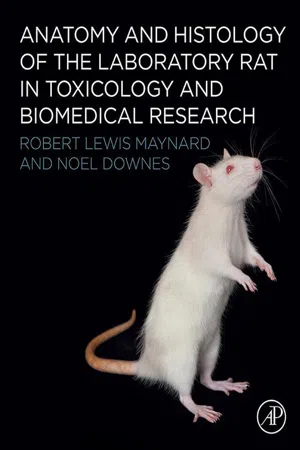Chapter 1
The Rat’s Place in Nature
This short chapter provides some zoological background to our study of the rat; for a more detailed account of topics dealt with in this chapter, the reader is advised to consult Cox and Hautier (2015).
Ignoring for a moment the rat’s teeth and jaw muscles, we can say that the rat is a rather unspecialised small mammal. The rat’s small size, undemanding requirements as regards diet and husbandry, rapid reproduction and an unspecialised physiology lead the toxicologist to choose it as a model for man. All mammals are characterised by mammary glands that are functional only in females, though Vaughan et al. (2000) reported a species of bat in which the males also lactate, and a number of other anatomical and physiological features. The following list is modified from Vaughan et al. (2000) and derived from a longer list provided by McKenna and Bell (1997) (Table 1.1).
Table 1.1
Diagnostic Characteristics of Mammals1. Jaw joint lies between mandible and squamous temporal bone; bones that formed the jaw joint in reptiles relegated to bones of the middle ear and external ear canal 2. Stapes small relative to size of skull 3. Atlas intercentrum and neural arches fused to form a ring of bone 4. Epiphyses present on long bones and girdles 5. Heart completely divided into four chambers 6. Heart has an atrioventricular node and Purkinje fibres 7. Single aortic trunk, invariably on the left 8. Pulmonary artery with three semilunar valves 9. Mature erythrocytes lack nuclei 10. Endothermic 11. Central nervous system covered by three meningeal layers: dura, arachnoid and pia mater 12. Cerebellum folded 13. Superficial muscles of the face expanded and differentiated 14. Muscular diaphragm present 15. Hair, sweat glands, sebaceous glands present 16. Mammary glands present 17. Kidney tubules characterised by a loop of Henle |
A number of these features will be described in the chapters dealing with organ systems.
Mammals are a class of vertebrates, the other classes are: fish, amphibians, reptiles and birds. Vertebrates themselves fall within the phylum Chordata, the chordates, which are characterised by the presence of a notochord at some stage of their life history. In addition to the mammals, the chordates include a small group of rather odd creatures that include the sea-squirts (tunicates) as examples of the Urochordata; the very odd acorn worms as examples of the Hemichordata, and the little lancelet (amphioxus or, more correctly, Branchiostoma lanceolatum) as one of the two genera of Cephalochordates. The vertebrates (named for the vertebrae that protect their spinal cords) or craniates (named for the crania that protect their brains) form a subphylum of the chordates. This subphylum can be divided into the small group of agnathans (fishes without jaws, including the lampreys and the hagfish) and a large group the gnathostomes (vertebrates with jaws). The gnathostomes include all fish (other than lampreys and hagfish), amphibians, reptiles, birds and mammals. It is widely known that when a new group arises in an evolutionary sequence, anatomical features of its parent group are retained, but often adapted for a different function. Tracing such evolutionary pathways has its own fascination, for example, the little bones of the mammalian middle ear (the malleus, incus and stapes) originated as breathing aids supporting the gill arches of primitive fish, then evolved into feeding aids as part of the jaws and of the jaw joint, and eventually ended up as hearing aids in the middle ear of mammals (Romer, 1970).
The Origin of Mammals
The surprisingly long history of mammals can be traced back to an early group of reptiles that appeared in the Permian period of the Palaeozoic Era. The annex to this chapter defines the sequence of geological time. The Permian was a time of reptile diversification. The group of reptiles that eventually led to mammals were the therapsids (Therapsida), of which the South African genus Cynognathus has been studied in detail. This early reptile was about the size of a large dog, a fast-moving carnivore with a well differentiated dentition. Most reptiles have an undifferentiated dentition, but Cynognathus had well developed canines (Cynognathus means dog jawed) and a series of cheek teeth that could chew meat. Cynognathus also had a respectable secondary palate to the roof of its mouth, a feature seen only in crocodiles among the reptiles. In other reptiles, the bony roof of the mouth is formed from other bones (see Chapter 5: The Skull) and the posterior nares lie well forward. The evolution of the secondary palate allowed the posterior nares to move back so that the air stream entering the nose was separated from the food entering the mouth. This was an important step as it allowed breathing and chewing to continue simultaneously, permitting the continuous supply of oxygen needed for the higher metabolic rate required by endothermic physiology. Despite these and other developments, perhaps including the appearance of hair, Cynognathus remained an egg laying reptile. The therapsids flourished in the Triassic period before becoming extinct, having lasted for 40 million or so years. There seems to be little doubt that they disappeared as a result of the competition provided by the so called Ruling Reptiles. These were flourishing and diversifying at the same time, and though perhaps not as physiologically advanced as the therapsids, they were clearly more successful. When the therapsids disappeared, they left behind them the fore-runners of the mammals, which were eclipsed by the dominant Ruling Reptiles for around 80 million years. How can we explain the survival of the fore-runners of the mammals?
In the 1960s, comparatively little was known of the history of the fore-runners of the mammals, but a lot more is now known, and some forms have been descri...

